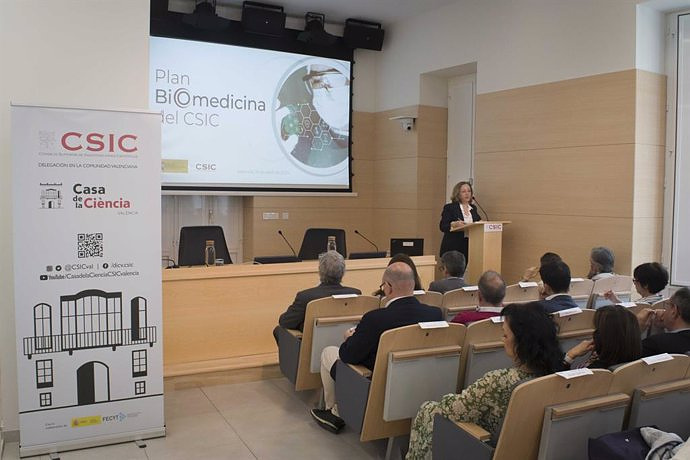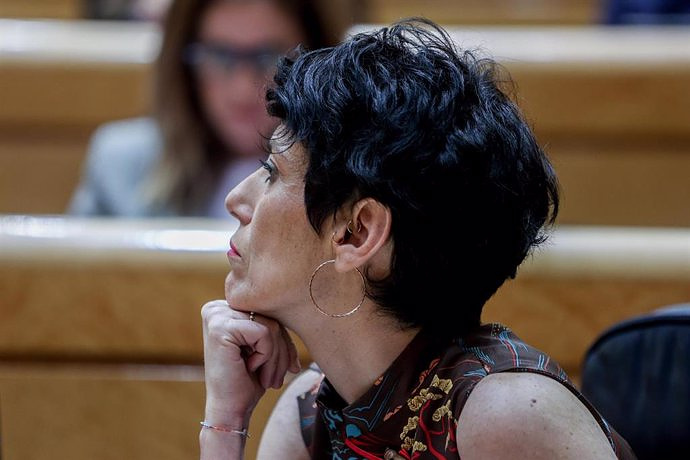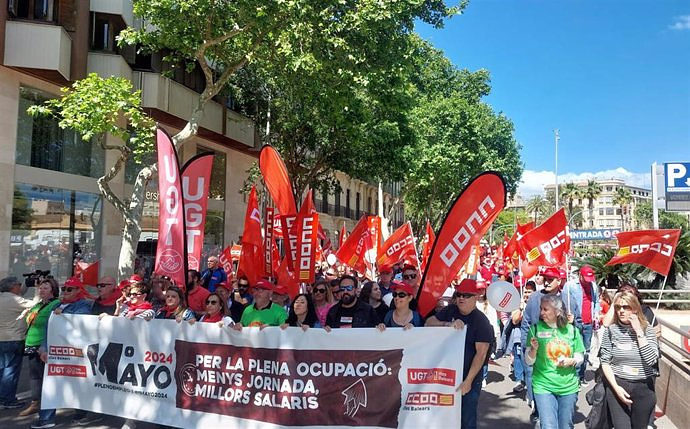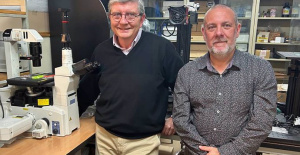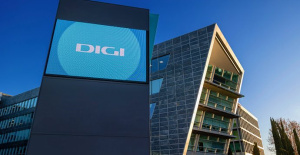VALENCIA, 19 Apr. (EUROPA PRESS) -
The Higher Council for Scientific Research (CSIC) incorporates into its Biomedicine Strategic Plan the challenges to "improve its positioning in the biomedical sector and prepare for challenges such as the application of robotics, nanotechnology and artificial intelligence to human health."
This was highlighted in the act of presentation of this roadmap that was held in the House of Science of the CSIC in Valencia, headquarters of the organization in the Valencian Community, and which was attended by the president of the CSIC, Eloísa del Pino, informs the body in a statement.
In addition, the vice president of Scientific and Technical Research of the CSIC, José María Martell, participated; the CSIC delegate in the Valencian Community, Juan Fuster; the deputy vice president of Innovation and Transfer of the CSIC, Ana Castro; the vocal advisor to the presidency of the CSIC, Isabel Varela; and the coordinator of the global Life area of the CSIC, which includes Biomedicine, Jordi Pérez.
The CSIC emphasizes that scientific research in Biomedicine has experienced significant growth in the last decade, a revolution as a consequence of technological and digital integration through the application of robotics, artificial intelligence, nanotechnology, etc.
The CSIC Presidency promotes the development of the CSIC Strategic Plan in Biomedicine, with the participation of the three Vice Presidencies (Scientific and Technical Research; Organization and Institutional Relations; and International Relations) and the Deputy Vice Presidency of Knowledge Transfer.
It is made up of 10 strategic axes, among which are strengthening internal communication; create new collaborative structures; strengthen the presence of the CSIC in key organizations through national and international collaborations, especially with the Carlos III Health Institute; or raise the degree of maturity of the projects presented to the industry. Within each axis, various action plans are defined.
"The Strategic Plan is the result of a meticulous sectoral analysis that this Presidency initiated with the vision of doing the best and most effective science possible with regard to biological science related to health, and that will help put us in the place of the European R D i that we deserve. This activity, which includes more than 2,200 projects from 500 research groups in our organization, shows that the CSIC is in a prominent position to lead and coordinate the biomedical challenges posed," indicated the president of the CSIC. CSIC.
In Valencia, the first three actions have been presented: the creation of a Rare Diseases Network, which will collect information from CSIC groups that develop projects in this area and which will serve to establish synergies; the OneHealth Fagoteca, which will serve to unify information on biological resources of this type; and the Biomed Transfer Services Network, which will highlight the scientific capabilities of the CSIC of interest to public and private agents and that are not accessible in other channels.
"The ultimate objective of this Strategic Plan is to create synergies within the state science and technology ecosystem that encourage their transfer to the health sector and citizens," remarked Jordi Pérez, researcher at the Institute of Biomedicine of Valencia (IBV-CSIC).
Among the key aspects analyzed in this plan is public-private collaboration as a necessary mechanism for the development and financing of innovative solutions; the incorporation of hospitals and health research institutes as essential agents in the translation to the patient and to validate developments; interaction with universities as agents of innovation in Biomedicine, in addition to promoting scientific careers and attracting young talent; and support for the creation of Technology-Based Companies (startups or spin-offs).
The vice president of Innovation and Transfer of the CSIC, Ana Castro, has highlighted that Spain occupies the 12th position in world scientific production, 15 by Gross Domestic Product (GDP) and 29 by translation in innovation, which shows that "scientific excellence is not is fully reflected in a knowledge economy". Thus, "if we transformed the potential of research excellence into an economic engine through innovation, we would have higher rates of progress and wealth."
CSIC research is organized into three global areas: Society, Matter and Life. The Life area is made up of more than 6,600 people (1,833 research staff), who carry out their activity in 1,330 groups, working in 62 research institutes located in all the autonomous communities. It is divided into Earth and Environment, Food Science and Technology, Agricultural Sciences and Biology and Biomedicine, which occupies a central role: 22 CSIC institutes work in this field, with more than 1,000 research groups and more than 700 researchers developing 3,491 projects and have made 1,576 patents.

 Exploring Cardano: Inner Workings and Advantages of this Cryptocurrency
Exploring Cardano: Inner Workings and Advantages of this Cryptocurrency Seville.- Economy.- Innova.- STSA inaugurates its new painting and sealing hangar in San Pablo, for 18 million
Seville.- Economy.- Innova.- STSA inaugurates its new painting and sealing hangar in San Pablo, for 18 million Innova.- More than 300 volunteers join the Andalucía Compromiso Digital network in one month to facilitate access to ICT
Innova.- More than 300 volunteers join the Andalucía Compromiso Digital network in one month to facilitate access to ICT Innova.-AMP.- Ayesa acquires 51% of Sadiel, which will create new technological engineering products and expand markets
Innova.-AMP.- Ayesa acquires 51% of Sadiel, which will create new technological engineering products and expand markets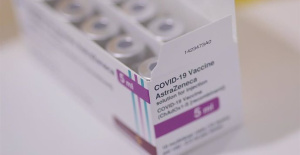 AstraZeneca admits that its Covid vaccine can cause side effects such as thrombosis in "very rare cases"
AstraZeneca admits that its Covid vaccine can cause side effects such as thrombosis in "very rare cases"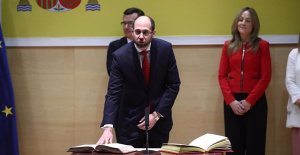 The PP signs the director of the cabinet of the governor of the Bank of Spain for its list for the European elections
The PP signs the director of the cabinet of the governor of the Bank of Spain for its list for the European elections Illa does not rule out agreeing with Junts after the Catalans if they do not prioritize independence
Illa does not rule out agreeing with Junts after the Catalans if they do not prioritize independence Los Angeles Police begin to dismantle the encampment at the University of California
Los Angeles Police begin to dismantle the encampment at the University of California How Blockchain in being used to shape the future
How Blockchain in being used to shape the future Not just BTC and ETH: Here Are Some More Interesting Coins Worth Focusing on
Not just BTC and ETH: Here Are Some More Interesting Coins Worth Focusing on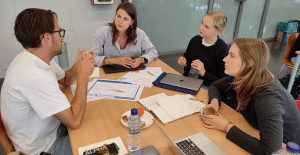 UPV students design an app that helps improve the ventilation of homes in the face of high temperatures
UPV students design an app that helps improve the ventilation of homes in the face of high temperatures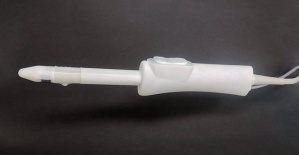 Ivace and promotes a less invasive device for the early detection of prostate cancer
Ivace and promotes a less invasive device for the early detection of prostate cancer Valencia unanimously approves the ordinance to allocate spaces to test innovative initiatives
Valencia unanimously approves the ordinance to allocate spaces to test innovative initiatives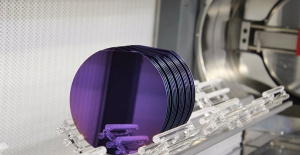 UPV researchers promote a paid master's degree as a "talent factory" in integrated photonics
UPV researchers promote a paid master's degree as a "talent factory" in integrated photonics A million people demonstrate in France against Macron's pension reform
A million people demonstrate in France against Macron's pension reform Russia launches several missiles against "critical infrastructure" in the city of Zaporizhia
Russia launches several missiles against "critical infrastructure" in the city of Zaporizhia A "procession" remembers the dead of the Calabria shipwreck as bodies continue to wash up on the shore
A "procession" remembers the dead of the Calabria shipwreck as bodies continue to wash up on the shore Prison sentences handed down for three prominent Hong Kong pro-democracy activists
Prison sentences handed down for three prominent Hong Kong pro-democracy activists ETH continues to leave trading platforms, Ethereum balance on exchanges lowest in 3 years
ETH continues to leave trading platforms, Ethereum balance on exchanges lowest in 3 years Investors invest $450 million in Consensys, Ethereum incubator now valued at $7 billion
Investors invest $450 million in Consensys, Ethereum incubator now valued at $7 billion Alchemy Integrates Ethereum L2 Product Starknet to Enhance Web3 Scalability at a Price 100x Lower Than L1 Fees
Alchemy Integrates Ethereum L2 Product Starknet to Enhance Web3 Scalability at a Price 100x Lower Than L1 Fees Mining Report: Bitcoin's Electricity Consumption Declines by 25% in Q1 2022
Mining Report: Bitcoin's Electricity Consumption Declines by 25% in Q1 2022 Oil-to-Bitcoin Mining Firm Crusoe Energy Systems Raised $505 Million
Oil-to-Bitcoin Mining Firm Crusoe Energy Systems Raised $505 Million Microbt reveals the latest Bitcoin mining rigs -- Machines produce up to 126 TH/s with custom 5nm chip design
Microbt reveals the latest Bitcoin mining rigs -- Machines produce up to 126 TH/s with custom 5nm chip design Bitcoin's Mining Difficulty Hits a Lifetime High, With More Than 90% of BTC Supply Issued
Bitcoin's Mining Difficulty Hits a Lifetime High, With More Than 90% of BTC Supply Issued The Biggest Movers are Near, EOS, and RUNE during Friday's Selloff
The Biggest Movers are Near, EOS, and RUNE during Friday's Selloff Global Markets Spooked by a Hawkish Fed and Covid, Stocks and Crypto Gain After Musk Buys Twitter
Global Markets Spooked by a Hawkish Fed and Covid, Stocks and Crypto Gain After Musk Buys Twitter Bitso to offset carbon emissions from the Trading Platform's ERC20, ETH, and BTC Transactions
Bitso to offset carbon emissions from the Trading Platform's ERC20, ETH, and BTC Transactions Draftkings Announces 2022 College Hoops NFT Selection for March Madness
Draftkings Announces 2022 College Hoops NFT Selection for March Madness